
Picture this: you’re standing in a courthouse corridor that smells faintly of paper, polish, and nerves.
Jurors are sizing you up. Clerks shuffle past with armfuls of files. Opposing counsel pretends not to notice you, but their eyes flick over anyway. You haven’t spoken a word – and yet your entire case already has a mood.
Why? Because people don’t just see your clothes; they interpret them like a headline in the New York Times (source).
So, how does a lawyer dress? If this is something that you want to know, keep on reading till the end…
How Does A Lawyer Dress?
The way in which a lawyer dresses matters a lot. And there’s a reason why I am saying so. Here are a few things that a lawyer keeps in mind while dressing:
- Dark wool suit (navy or charcoal): Think Churchill in war cabinet meetings – serious, composed, ready to command. At 270-300 gsm, wool breathes enough to keep you calm but heavy enough to stay upright after hours of sitting.
- Crisp shirt: White isn’t boring – it’s power. Blue is diplomacy in cotton. The collar point length is around 3 inches, keeping ties from slouching like a tired intern.
- Conservative tie: Grenadine silk has the quiet gravitas of a first-edition Blackstone – matte, textured, commanding respect without shouting.
- Polished Oxfords: Closed lacing, black cap-toes. No square toes, unless your strategy is “convince judge I moonlight as a nightclub bouncer.”
- Structured briefcase: Imagine the difference between Tolkien’s meticulous manuscripts and a teenager’s stuffed backpack. Go with an upright, rectangular, full-grain leather briefcase. Because sag? Not an option.
- Minimal jewelry: Watch dials under 40 mm. Anything oversized risks looking more Vegas than verdict.
- Grooming: Hair under control, nails trimmed, fragrance measured in drops not clouds. Think Supreme Court chambers, not Abercrombie & Fitch mall kiosk.
Example to chew on: Two candidates, same résumé. One in navy worsted with a midnight grenadine tie, black Oxfords polished like Steinway keys. The other is shiny poly-blend, brown square-toe shoes, and a bag that slumps against the wall. Both are equally qualified, but who do you trust to cross-examine your future?
Takeaway: Dress one notch more formal than the decision-maker.
Once you’ve hit formality, the spotlight shifts to fit. Next: how judges clock tailoring mistakes faster than you can say “objection.”
Which Fit Details Do Judges Clock From 12 Feet Away?
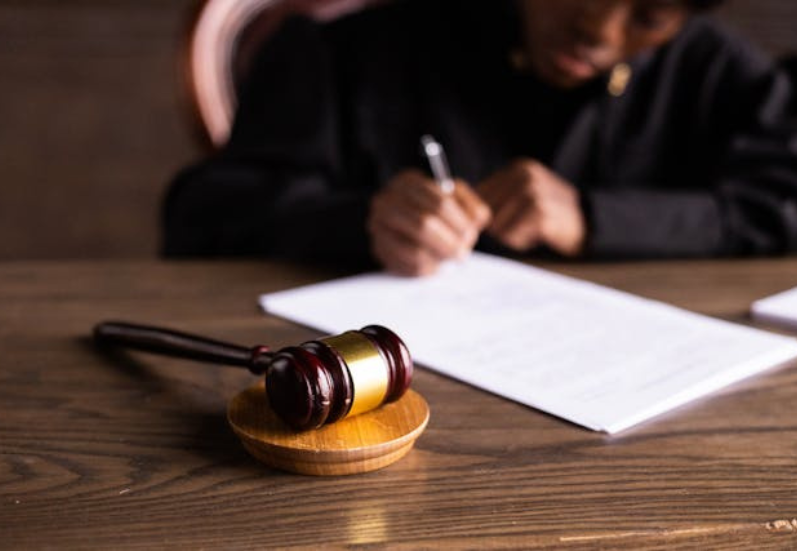
Ever seen a judge lean back, squint, and then raise an eyebrow – not at your argument, but at your wrinkled lapels?
Fit is discipline, plain and simple.
If the jacket puckers, if the trousers puddle, it doesn’t matter that you quoted Marbury v. Madison in your sleep; you still look like you lost the fight with your laundry.
- Shoulders: The seam belongs exactly at the acromion bone. Push past by more than 1 cm, and suddenly you’re wearing your father’s blazer in a high school play.
- Chest/waist: That “X” wrinkle across the button? It’s basically a flashing neon sign that says “Too Tight.” Conversely, a loose midsection reads as “borrowed from lost-and-found.”
- Jacket length: If it doesn’t cover your seat, your credibility shrinks with it. Thumb-knuckle test, always.
- Sleeves: Courtroom magic happens in fractions of an inch: show 0.25-0.5 inches of shirt cuff. Enough for intention, not enough for distraction.
- Trousers: A single break – barely a kiss of fabric on the shoe. Pile-up at the ankle? That’s courtroom slapstick.
- Skirts/dresses: At the knee. Not above, not floor-length. Slits that climb higher than 4 inches become the conversation you didn’t plan to have.
Gift hack: Tailoring credit. Nothing says “I believe in your future” like $150 earmarked for sleeve shortening and waist suppression.
Real-world scene: Same charcoal suit. Sleeves ½ inch too long? Looks like you got dressed in the dark. Sleeves hemmed to show cuff? Suddenly, you’re Cary Grant pacing a witness box.
Takeaway: Tailoring beats labels. Once the fit is flawless, fabric tells the silent story. Next: why some suits whisper expensive from across the room.
Read Also: The Value of Deposition Transcripts in Courtroom Strategies
Which Briefcase Quietly Says “Prepared” Before You Speak?
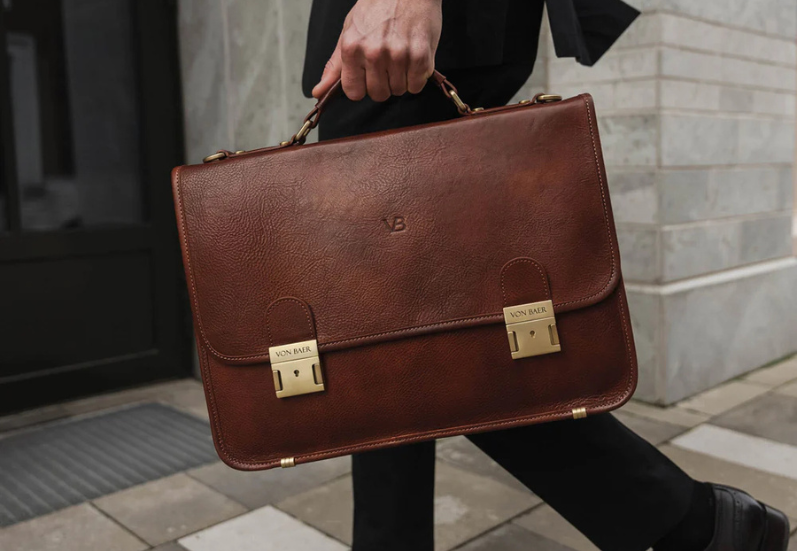
Briefcases are stage props with plot power. Drop a sagging nylon bag on counsel’s table, and you may as well be auditioning for a sitcom about rookie lawyers.
Set down a structured full-grain vegetable-tanned leather briefcase, and you’ve just walked into a John Grisham adaptation.
- Attaché or structured (hard-sided): Slim, crisp, depth 7-9 cm. Pristine papers only. Downsides? Formal (if you work in creative).
- Zip-top leather brief: The daily grind champion. Width 10-14 cm, laptop compartment padded. Detachable strap, drop length 50 cm. Upright, no slump.
- Slim folio: Ideal for iPad, padfolio, light hearings. Pair with a litigation trolley (42-46L capacity) for trial weeks.
Quality signals: Full-grain leather 1.8-2.2 mm thick (source), stitching density 6-8 stitches per inch. Zippers? YKK Excella or Riri. Protective feet 5-7 mm high.
Gift tiers: <$600 gets solid basics. $700-2000 buys lifetime-repair heirlooms. Add-ons? Cord pouch, padfolio – because nothing says “prepared” like not having your charger tangled in highlighters.
Which brand is best? We really like the Von Baer Lawyer Briefcases, because they’re handmade from full-grain vegetable-tanned leather, which is the best quality you can buy, and they use solid brass hardware, which looks really smart.
Example in action: Deposition morning. One lawyer unzips a full-grain zip-top, files tabbed, laptop secure. Bag upright, square. Opponent’s nylon satchel slumps sideways, spilling exhibits like a bad magic trick.
Takeaway: If the bag collapses, so does your aura. With armor intact, it’s time to talk survival. Next: tools to stay fresh when 4:15 p.m. feels like midnight.
Why Do Some Suits Look Expensive from Across the Room?
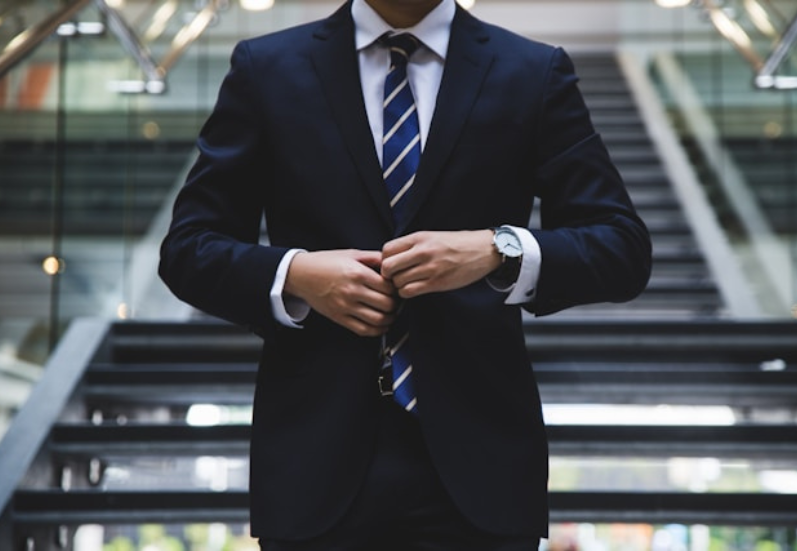
Ever notice how certain lawyers seem untouched by eight hours of fluorescent interrogation lights, while others wilt like yesterday’s salad? That’s fabric doing its job – or failing.
High-twist wool behaves like a stoic litigator who never sweats; polyester blends behave like interns on their first deposition.
1. Worsted wool weights: Here are a few things that you should keep in mind:
- 220-260 gsm: summer, humid offices. Lightweight, airy – but can lose shape.
- 270-300 gsm: all-season, the workhorse. Drapes without collapsing, keeps you safe under camera scrutiny.
- 310-340 gsm: winter-only. Heavy, lush, like putting on gravitas itself.
2. Weaves: Poplin = crisp as a new casebook spine. Twill = diagonal resilience. Hopsack = breathable, but too informal for a courtroom’s gravitas.
3. Shirts: Poplin (crisp, formal), twill (wrinkle-masking), oxford (casual Friday).
4. Ties: Grenadine (grossa weave for texture, fina for subtlety). Repp stripes? A nod to Ivy League seriousness.
5. Colors matter too: Navy signals reliability, charcoal competence. Black is for funerals, not Tuesday hearings. White shirts photograph clean at 90% reflectance; blue softens edge at 65%.
Example: Deposition on camera, 4000K fluorescent glare. Charcoal twill worsted drapes unbothered. Opponent in poly-blend? Elbows shine like diner countertops after two hours. Which one feels more credible to the client watching the playback?
Takeaway: Texture hides stress, color tames light. Fabric done, now it’s your tools. Next: the bag that speaks before you do.
Why Certain Bags Become Long-Term Allies?
Not every leather bag earns the right to sit beside you through trials, client meetings, and endless airport security lines. Some wear out, some sag, some simply never look intentional.
A handful, though, have the kind of craftsmanship that holds up under years of pressure – becoming part of the professional uniform as much as the suit itself.
- Structured design: Bags with reinforced sides and a rigid base maintain posture even when empty. A collapsing bag signals disarray.
- Interior layout: Two main compartments work best: one padded section for a laptop up to 16 inches, and one for files. Add a slim zip pocket for confidential items like passports or sensitive notes.
- Handles and straps: Handles with reinforced stitching last decades. Shoulder straps should be wide enough to distribute weight – 3.5 to 4 cm is the sweet spot.
Concrete example: Closing argument day. Counsel arrives with a full-grain brief, dark espresso color, edges burnished by years of use. The bag stands upright beside the counsel table.
Jurors glance, see order, see stability. Contrast: opposing counsel with a canvas messenger – strap frayed, shape sagging sideways on the floor. One says continuity, the other says “temporary.”
Takeaway: The right bag doesn’t just carry documents – it carries years of earned credibility.
When the bag itself becomes a quiet constant, clients notice.






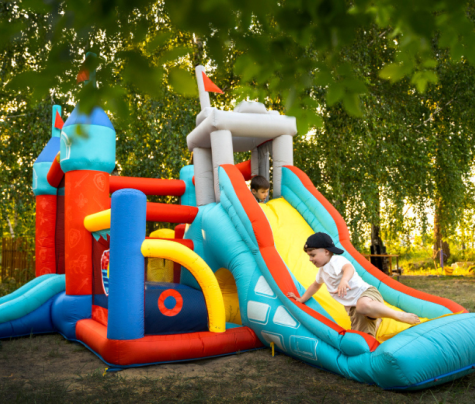
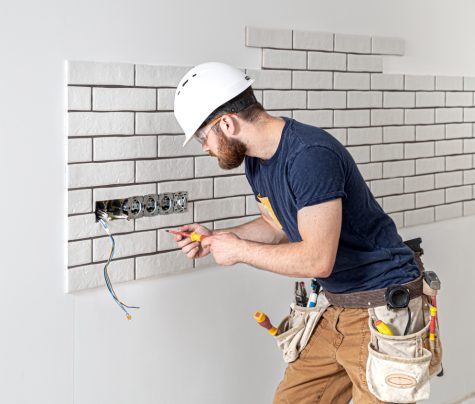
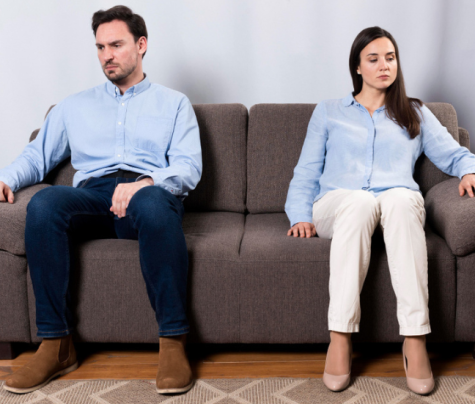

0 Reply
No comments yet.